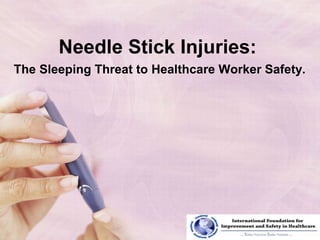
Needle Stick Injury Presentation
- 1. Needle Stick Injuries:The Sleeping Threat to Healthcare Worker Safety.
- 2. Today Scope of the problem. Implementation of Risk Management Program identification analysis prevention and control Lessons to be learnt.
- 3. Question? Where is the most dangerous place to work?
- 5. Question? What is the single greatest occupational hazard to medical personnel?
- 7. Scope of the ProblemInternationally Before 1980, needlestick injury prevention was not as much of an issue (pre-AIDS). In the late 1980’s the Centers for Disease Control and Prevention (CDC) introduced “Universal Precautions” to protect healthcare workers from bloodborne pathogens. 1991, The Occupational Safety and Health Administration (OSHA) published its rule “Occupational Exposure to Bloodborne Pathogens” to further protect healthcare workers.
- 8. Scope of the ProblemInternationally While as many as 20 blood borne pathogens can be transmitted through accidental NSI’s, the potentially life threatening are HIV, hepatitis B virus (HBV) and hepatitis C virus (HCV). A health care worker’s chance of contracting HIV 1:250 HBV 1:20 HCV 3.5:100
- 9. Scope of the ProblemLocally 2006- Only 6 cases reported. There was a lack of information about the various factors that cause accidents with needles. No Surveillance program to provide in-depth information. No analysis of the data collected which could provide useful information for designing effective prevention strategies.
- 10. Implementation of Risk Management Program. “One of a number of organisational systems or processes aimed at improving the quality of healthcare, but one which is primarily concerned with creating and maintaining safe systems of care.”
- 11. Incidence of needle sticks injury Reporting to supervisor First aid for the employee OVA form Reporting to QMD, Writing OVA Employee examination in ER, EHC Negative results of investigation History taken, complete physical examination Employee consent Employee serological tests for HBs AG, Anti HBs, Anti HCV, anti HV Post exposure prophylaxis Management of exposure Patient MRP notification, patient examination Continuous monitoring according to IPP Employee counseling Patient consent Patient serological tests for HBs AG, Anti HBs, Anti HCV, anti HV All measures according to IPP implemented
- 21. Risk Prevention and Control Perform a walk-through of your facility to assess the locations, emptying schedules, and security of containers. Does the sharps container require one or two hands to operate? Are the sharps containers located in convenient locations and at the proper height?
- 22. Risk Prevention and Control The optimal installation heights for fixed, wall-mounted containers are: Standing workstation: 52-56 inches above the standing surface of the use Seated workstation: 38-42 inches above the floor on which the chair rests
- 23. Risk Prevention and Control Procedures: Receive training and PRACTICE before you perform a procedure on a patient, whether or not a safety product is being used. Products: Familiarize yourself with the products before you use them. If a safety product is used, always use it correctly and consistently to avoid a NSI.
- 24. Risk Prevention and Control ALWAYS be considerate of others. Dispose of all used needles and sharps in the appropriate containers. Expect the unexpected. Have an adequate number of supplies readily available for the procedure and ask for help from a co-worker if necessary. Beextracareful during emergent situations. Always keep exposed needles pointed down and away from yourself and others. Alert co-workers when you have a needle or sharp in your hand.
- 25. Risk Prevention and Control Always wear properly fitting personal protective equipment - gloves, eye protection, etc. Never reach into trash cans, basins or other containers with your hands. You never know when there might be a hidden needle. Never place trash against your body to compress or secure it!
- 26. Risk Prevention and Control-Education! Education of healthcare workers is critical in promoting a safe environment. It should be provided during orientation, annually, and on a “as-needed” basis to all healthcare workers. Those who actually use needles and other sharp objects should be given additional training, including “hands-on” sessions in using products.
- 27. Lessons to be Learnt Blood collection, device use and disposal are part of a complex multistep process. Safety devices and safety procedures do not work alone. Interdisciplinary approach. Promotion of organisational safety culture. Leadership and managerial support.
- 28. Employee Safety
- 29. Thank You!